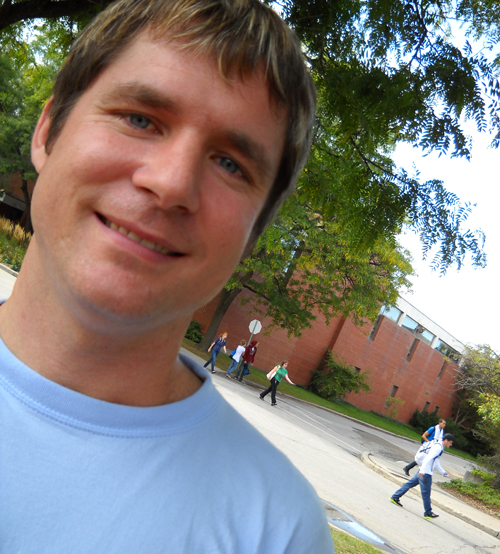
“Are you going to be on David Suzuki?” That’s what one youngster asked one day last fall during Graham Slater’s customary research ride through a Toronto park. Another time, the Guelph grad student was pulled over by a police officer who wanted to check out the suspect mechanism mounted on the handlebars of his mountain bike.
Slater didn’t mind the attention.
His two-wheeled pursuit of a master’s degree in landscape architecture saw him occasionally playing U of G ambassador to curious Torontonians last fall. Surprisingly, he says, a few passersby actually knew that the instruments mounted on his homemade bike gizmo measured microclimate variables like temperature and humidity.
This fall his work gained more attention. His thesis project ─ “The Cooling Ability of Urban Parks” ─ won an international student research excellence award from the American Society of Landscape Architects (ASLA). He received the award in September in Washington, D.C.
Prof. Robert Brown, School of Environmental Design and Rural Development, says the ASLA competition attracts student entries from around the world, but the jury seldom gives out the excellence award. Referring to his student, Brown says the award is “a tremendous recognition of his accomplishment and also of the quality of research done in the master of landscape architecture program at the University of Guelph.”
Slater, who graduated this spring, spent three years working with Brown and Terry Gillespie, professor emeritus in the School of Environmental Sciences. They study human thermal comfort, or how to use wind, temperature, sunshine and other climatic factors to design optimum outdoor spaces for people.
Big cities are getting bigger and warmer, says Slater. He wondered how much parks and green spaces might help to cool the surrounding streetscape, providing relief and maybe even improving health for city dwellers during sweltering summers.
To find out, he chose four parks in Toronto; the city’s recorded warming trends and high urban density make it a likely model for tomorrow’s urban conditions. He drove into the city from Guelph last year to conduct measurements; he’s now living in an apartment in Toronto’s Leslieville area near the Beaches.
For his thesis, he ended up using data from Withrow Park alone, the only site where wind direction remained constant during his 10-day study in September 2009.
All four parks were bounded by streets on all sides and were bisected by roads that allowed Slater to pedal a straight line through and beyond the space.
Recording during each transect from before the park entrance and beyond its exit, his instruments measured temperature, solar radiation and humidity. By visiting early afternoons on sunny days, he hoped to hit the hottest part of the day to record the widest heating-cooling differential.
He found that parks were up to 7 C cooler than the surrounding streets and that their cooling effect could extend almost 100 metres into the neighbourhood, depending on the amount of traffic nearby.
His advice for urban planners and landscape architects in designing neighbourhoods and urban spaces? Establish more, smaller parks rather than one single large oasis. “Busy streets should be positioned away from the edges of parks and parallel to prevailing summer winds to allow cool air extension from parks.”
Slater suggests planting lots of shade trees in parks and along city streets. Broad-leaved trees like maples and oaks substantially reduce air temperature, not just from shade but from releasing cooling water vapour into the air.
An area with trees also cools better than a large green space without them. “Open grass areas can be almost as warm as an open street in the sun on hot, sunny days.”
Among the few studies of parks’ urban cooling, he says, most have measured in “snapshot” fashion rather than completing a continuous stream of data as Slater did. That allowed him to look at changes throughout the park, not just cool or hot spots.
He got interested in microclimates after taking a course with Brown early in his master’s program. Brown had looked at the cooling effects of rice paddies in Japan.
Earlier, Slater studied kinesiology at the University of Waterloo. He practised landscape construction for 10 years before returning to school three years ago. He hopes to continue studying microclimate and landscape design.